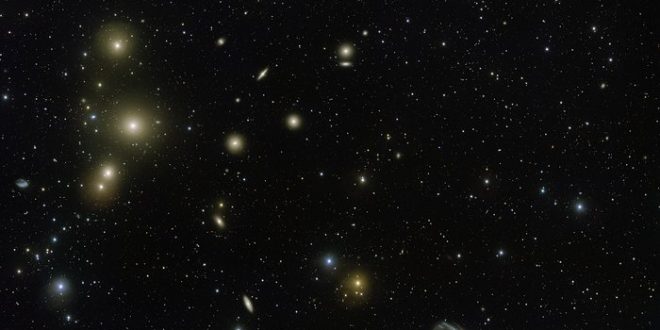Cannibal Galaxy Gets Bigger by Gobbling Up Galactic Neighbors.
It’s a cluster of almost 60 galaxies, the centre of which lies 65 million light-years from Earth.
Using the VLT Survey Telescope at the European Southern Observatory in Chile, astronomers have imaged in incredible detail one of the closest galaxy clusters to Earth, called the Fornax Cluster.
Galaxy clusters demonstrate gravity’s power over long distances, with the gravitational influence of dark matter and the visible galaxies themselves leading to the cosmic groupings. These cosmic clusters typically contain from 100 to 1,000 galaxies at a width of 5 to 30 million light-years across. (One light-year is the distance light travels in a year, about 6 trillion miles or 10 trillion kilometers).
The Fornax Cluster, at roughly 65 million light-years from Earth, includes about 60 large galaxies and about as many dwarf galaxies. The centerpiece of this cluster is NGC 1399, which is known as a cD galaxy — a type often considered as a “galactic cannibal,” according to ESO officials.
“This is because they have grown by swallowing smaller galaxies drawn by gravity towards the center of the cluster,” ESO representatives wrote in an image description.
A team of astronomers using data from ESO’s VST discovered a bridge of soft light between NGC 1399, at the center of the trio of blurry balls of light on the left of the image, and NGC 1387. This find, which is not visible in this image, supplies evidence for the effects of gravity in creating and changing these clusters.
On the bottom right side of the image is NGC 1365, a large barred spiral galaxy with a secret — a supermassive black hole at its heart.
ESO’s VLT Survey Telescope is 2.6 meters in diameter and was created to perform large-scale surveys of the sky with a huge corrected field of view and OmegaCAM — a 246-megapixel camera designed specifically for this task. The VST quickly provides deep images of massive swaths of sky, as compared to ESO’s Very Large Telescope which focuses on details of particular cosmic targets.
Agencies/Canadajournal

 Canada Journal – News of the World Articles and videos to bring you the biggest Canadian news stories from across the country every day
Canada Journal – News of the World Articles and videos to bring you the biggest Canadian news stories from across the country every day

